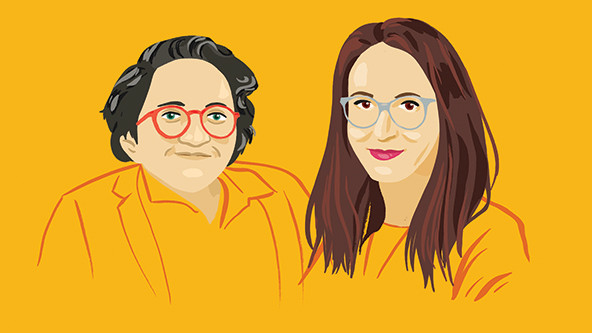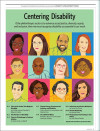 Sandy Ho and Jen Bokoff (Illustration by Shannon May)
Sandy Ho and Jen Bokoff (Illustration by Shannon May)
Sandy’s Introduction
“What kind of funding are you looking for, and do you have a budget for this year?” a staff person from a foundation asked me. We were talking about the 2018 Disability & Intersectionality Summit (DIS). It came as a shock when I, the event’s founder, landed a meeting with this foundation to discuss DIS.
Centering Disability

If the philanthropic sector is to advance social justice, diversity, equity, and inclusion, then it must recognize disability as essential to its work. This supplement offers critical perspectives and recommendations for dismantling ableism. Sponsored by the Disability & Philanthropy Forum
It was one of my earliest interactions with a foundation as a community organizer and I recall trying my hardest to impress this staff person. As a disabled and queer Asian American woman, I felt such shock partly because our ableist society has conditioned me and millions of disabled people to wait and be told what would be best for our lives, rather than asking directly for what we need.
Ableism is a system of oppression that devalues and discriminates against people with disabilities. Individuals as well as institutions, policies, and communications can be sources of ableism.
Jen’s Introduction
For years, I have been part of and an observer to ableist gatekeeping in philanthropy. From a “go, go, go” work culture to the invitation of proposals and office and event design, the philanthropy sector is not without its share of ableism. I’ve spent much of my career operating in systems that have not honored what my body needs to be successful, because of both structural ableism and ableism that I’ve internalized. As a person with chronic illnesses, I didn’t know about accommodations I could request or boundaries I could set, because I didn’t see them modeled around me. When I once tried to share my experiences with pain, fatigue, sensory sensitivity, and digestive needs at a former team retreat, I was met with disbelief and laughter. The awkwardness sent a clear message: It’s easier just to keep it to yourself.
But it shouldn’t be awkward. The philanthropy sector has waved the banner of “diversity, equity, and inclusion” for years, and yet ableism continues to affect staffing and talent development, knowledge generation and sharing, and governance and funding. I have even inadvertently perpetuated ableism. For example, I never knew to ask direct reports if they needed accommodations, and I have readily spoken at inaccessible events. I’ve been on my own learning—and action—journey to change this.
Ableism in Our History, Policies, and Structures
Philanthropy is no stranger to the ways that ableism is deeply embedded in the perceptions and treatment of disabled people. Historically, many charitable foundations have solicited or made donations intending to “cure” disabled people, based on the so-called “medical model” of disability. While some of these organizations enabled access to services, much of their work framed disability in a way that contributed to notions that disabled people are in pitiable positions and are in need of fixing—also known as the “charity model” of disability. Both the medical and charity models portray people with disabilities as objects rather than subjects, which can contribute to ableism and impede the achievement of and access to rights and justice.
The philanthropic sector has started to show improvement in its understanding of disability and has made marginal increases in disability-inclusive grantmaking. These efforts aren’t enough, however, given that one in four adults in the United States has a disability. For philanthropy to address systemic ableism head-on, it must put meaningful action behind the banner of diversity, equity, and inclusion.
Funders must elevate and expand their practice so that they’re not only combating ableism but also being actively anti-ableist in their efforts to achieve a just society. Solutions to inequality cannot happen without addressing ableism. Unless there is an increase in intentional, transparent anti-ableist practices from the sector, philanthropy’s aims to resource cross-movement work, minimize inequality for marginalized communities, and move equity forward will remain unfulfilled.
This isn’t easy work. But there’s good news: Once you start the work of disability inclusion and disability justice, the broader work of building collective power and equity goes deeper and becomes readily apparent.
Ideas for Dismantling Ableism in Philanthropy
Rooting out embedded systematic oppression will take more than one program officer, funding priority, or call for proposals. It requires a collaborative and dedicated multilayered strategy. Based on our experiences, here are seven ideas for philanthropy to consider:
- Ableism doesn’t exist in a vacuum. For philanthropy to play a role in systems change, it must first understand that disability coexists with other identities, and that other forms of systemic oppression also contribute to and intersect with ableism. Philanthropy must replace charity- and medical-model lenses with both justice- and rights-based 1 understandings. Cross-movement disability strategies should become the norm within grantmaking and funding. Siloing disability from other movements and justice work only serves to further isolate multimarginalized disabled people. When foundations address ableism separately from other forms of oppression, they can’t achieve systems change.
- Hire, support, and promote disabled talent. Nondiscrimination hiring policies are important, but actively hiring disabled talent is crucial. This commitment means supporting disabled people to take on roles across organizations, beyond those with a disability focus. To shift workplace culture, foundation staff must actively make space and listen with openness to disabled team members on matters ranging from human resource practices to grantmaking policies. Rather than treating disability like a secret shame, foundations should also realize the statistical likelihood that disabled staff and leadership already exist within their organization. Third Wave Fund, a philanthropy that supports youth-led, intersectional gender justice activism, demonstrates how learnings from disabled leaders in their organization and their communities have created an organization that is more resilient and in line with their social justice values.
- Ensure that your grantmaking processes and technologies are accessible. Philanthropy must eliminate gatekeeping in how funding opportunities are structured, shared, and applied for. The design of funding opportunities matters: Does the framing of requests for proposals take into account the needs and perspectives of persons with disabilities? Does it consider multiple layers of identity including disability, or is disability excluded? Are there requirements that might exclude organizations of persons with disabilities? Technology matters, too. In the latest A Consumer Guide to Grants Management Systems, only 5 of the 14 evaluated products mention accessibility. A fully accessible technology platform might mean that people who use screen readers and other assistive devices can access the application, and that it is available in plain language and multiple languages. For the Disability Rights Fund (DRF), this accessibility is critical not only because inclusion is a value, but also because persons with disabilities participate at all levels of the organization. DRF uses a participatory grantmaking approach that puts disability activists in the grants decision-making seat. Participatory approaches like these deviate from traditional philanthropic processes and are directly anti-ableist.
- Be in active partnership with disability communities. The disability community is not a monolith and the diversity within this community across disability types and social/cultural identities is important to bear in mind. Regularly connecting with and listening to people with all types of disabilities who reflect a range of identities matters, not only for disability-specific funding priorities, but also for including disability in meaningful ways across all work. Disability-specific organizations often take on the uncompensated labor of educating donors. Pay disabled people for their time and labor to engage in ongoing dialogue and consulting. Listening with the intent to learn will help frame challenges, approaches, and theories of change in new ways, and will help foundations reconsider existing structures and the support they provide. Remember: Humility is essential. Even though Sandy identifies as disabled, and Jen as a person with chronic illness, we’re still constantly listening and learning.
- Build data about disability. Data is critical for awareness and advocacy. Right now, there is a dearth of data about how many persons with disabilities work in or serve on boards in the philanthropy sector, and there is limited data on funding that supports disabled people or disability-led organizations. (CHANGE Philanthropy’s The 2020 Diversity Among Philanthropic Professionals Report has some data on sector talent, and Candid and the Human Rights Funders Network house data online on foundation funding.) Addressing this lack of data, which suggests that disabled talent and disability-focused initiatives remain largely excluded, would make it possible to demonstrate gaps in ways that cannot be ignored. While developing and deepening the data, it’s also important to consider the ethics of doing so. Who contributes to and sources data? Is the data properly framed and used? Who is it available to? Who does it benefit, and who does it hurt? These are key considerations to confront and build from.
- Proactively support disabled-led initiatives and organizations. Resourcing grassroots disability initiatives with funding and networks is essential. Disabled leaders and organizations of persons with disabilities may have limited bandwidth and networks to seek out and apply for funding opportunities. Many simply ignore opportunities that don’t explicitly mention disability because the funding doesn’t appear to be intended for them. Go out and find them; active partnership with disability communities is important and can help funders understand existing work led by disability communities. “Nothing about us without us”—the mantra of the disability rights movement—should be a guiding principle. Be wary of organizations that talk about disability but do not have people with disabilities in leadership positions, including governance. These organizations tend to practice the charity mindset. Make sure this work has a home within your foundation, whether through dedicated portfolios, such as the ones Third Wave Fund and Open Society Foundations maintain, or as a priority that is embedded across portfolios, which is how the Ford Foundation operates. Furthermore, make sure that every portfolio recognizes intersections with disability. For example, if a foundation has a women and girls portfolio, is there awareness that one in five women around the world has a disability, and that this intersection must be understood and supported for the portfolio to be successful?
- Call peers and stakeholders into learning and constant improvement. The Presidents’ Council on Disability Inclusion in Philanthropy consists of foundation presidents who are committed to disability inclusion as part of improving diversity, equity, and inclusion in philanthropy. The council established the Disability Inclusion Fund, housed at Borealis Philanthropy, to start moving more resources, and created the Disability & Philanthropy Forum, which is dedicated to fostering community learning through field-wide conversations and reflections on the disability inclusion journey. The forum is available for all practitioners to join. Beyond the forum, we can all be active advocates and learners. When a funder talks about the inclusion of marginalized communities, ask what they are doing for people with disabilities. When they inevitably look perplexed and say that’s not an explicit focus, be prepared to have a conversation about why this is important. Keep learning and bringing your colleagues on the learning journey, too.
Dismantling ableism in philanthropy is not a nice-to-do; it’s a must-do. Without concerted efforts to root out ableist oppression, we cannot meaningfully address injustice and inequality. The ideas we offer here are just some steps that philanthropy can take to become anti-ableist to move toward transformation.
Support SSIR’s coverage of cross-sector solutions to global challenges.
Help us further the reach of innovative ideas. Donate today.
Read more stories by Sandy Ho & Jen Bokoff.

